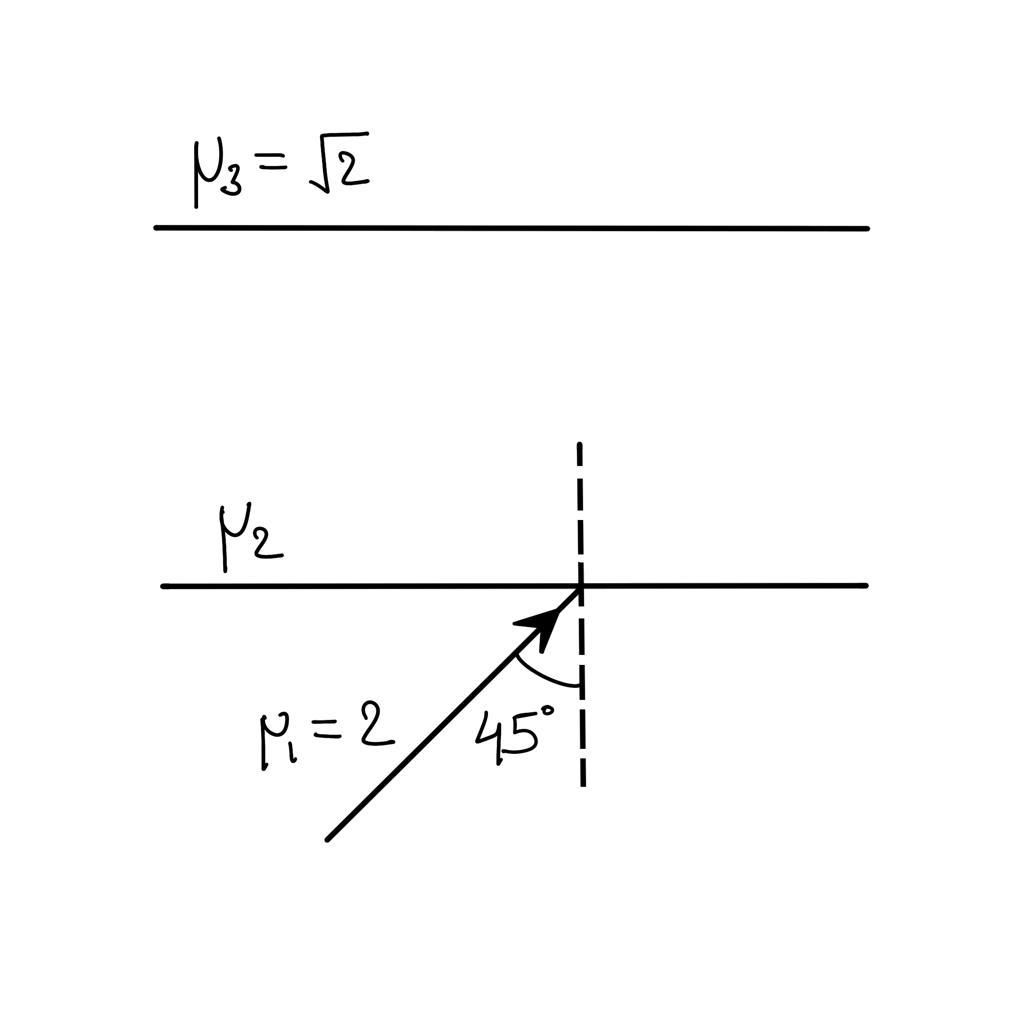
Answer
464.4k+ views
HINT- In this question we will use the concept of total internal reflection. Total internal reflection (TIR) is the optical phenomenon in which the surface of the water in a fish tank (for example) when viewed from below the water level, reflects the underwater scene like a mirror, with no loss of brightness. In general, TIR occurs when waves in one medium reach the boundary with another medium at a sufficiently slanting angle, provided that the second medium is transparent to the waves and allows them to travel faster than in the first medium.
Step-By-Step answer:
Now coming back to question, Critical angle is given by:
\[{\theta _c} = {\sin ^{ - 1}}(\dfrac{{{\mu _2}}}{{{\mu _1}}}) = {\sin ^{ - 1}}(\dfrac{{{\mu _2}}}{2})\]
If $\mu < \sqrt 2 $, then total internal reflection takes place and the ray reflects back, the angle of deviation is ${45^0} + {45^0} = {90^0}$
If $\mu = \sqrt 2 $, then the ray passes tangentially at the first medium. Then, the angle of deviation is ${45^0}$
If $\mu > \sqrt 2 $, then the ray enters the second medium and the angle of refraction at third interface is given by:
${\mu _1}\sin {\theta _1} = {\mu _2}\sin {\theta _2} = {\mu _3}\sin {\theta _3}$
For 1st and 3rd medium,
$2\sin 45 = \sqrt 2 \sin {\theta _3}$
$\sin {\theta _3} = 1$
The angle of refraction is ${90^0}$
The deviation is $90 - 45 = {45^0}$
Therefore, option $A.$ and $B.$ are correct options for the above question.
NOTE- CRITICAL ANGLE
The angle of incidence beyond which rays of light passing through a denser medium to the surface of a less dense medium are no longer refracted but totally reflected.
So the critical angle is the angle of incidence that provides an angle of refraction of 90-degrees. For the crown glass-water boundary, the critical angle is 61.0 degrees. The actual value of the critical angle is dependent upon the combination of materials present on each side of the boundary.
Step-By-Step answer:
Now coming back to question, Critical angle is given by:
\[{\theta _c} = {\sin ^{ - 1}}(\dfrac{{{\mu _2}}}{{{\mu _1}}}) = {\sin ^{ - 1}}(\dfrac{{{\mu _2}}}{2})\]
If $\mu < \sqrt 2 $, then total internal reflection takes place and the ray reflects back, the angle of deviation is ${45^0} + {45^0} = {90^0}$
If $\mu = \sqrt 2 $, then the ray passes tangentially at the first medium. Then, the angle of deviation is ${45^0}$
If $\mu > \sqrt 2 $, then the ray enters the second medium and the angle of refraction at third interface is given by:
${\mu _1}\sin {\theta _1} = {\mu _2}\sin {\theta _2} = {\mu _3}\sin {\theta _3}$
For 1st and 3rd medium,
$2\sin 45 = \sqrt 2 \sin {\theta _3}$
$\sin {\theta _3} = 1$
The angle of refraction is ${90^0}$
The deviation is $90 - 45 = {45^0}$
Therefore, option $A.$ and $B.$ are correct options for the above question.
NOTE- CRITICAL ANGLE
The angle of incidence beyond which rays of light passing through a denser medium to the surface of a less dense medium are no longer refracted but totally reflected.
So the critical angle is the angle of incidence that provides an angle of refraction of 90-degrees. For the crown glass-water boundary, the critical angle is 61.0 degrees. The actual value of the critical angle is dependent upon the combination of materials present on each side of the boundary.
Recently Updated Pages
Who among the following was the religious guru of class 7 social science CBSE

what is the correct chronological order of the following class 10 social science CBSE

Which of the following was not the actual cause for class 10 social science CBSE

Which of the following statements is not correct A class 10 social science CBSE

Which of the following leaders was not present in the class 10 social science CBSE

Garampani Sanctuary is located at A Diphu Assam B Gangtok class 10 social science CBSE

Trending doubts
Which are the Top 10 Largest Countries of the World?

Fill the blanks with the suitable prepositions 1 The class 9 english CBSE

How do you graph the function fx 4x class 9 maths CBSE

Find the value of the expression given below sin 30circ class 11 maths CBSE

In what year Guru Nanak Dev ji was born A15 April 1469 class 11 social science CBSE

The Equation xxx + 2 is Satisfied when x is Equal to Class 10 Maths

Why is there a time difference of about 5 hours between class 10 social science CBSE

Difference between Prokaryotic cell and Eukaryotic class 11 biology CBSE

What is BLO What is the full form of BLO class 8 social science CBSE





